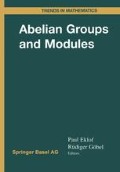Abstract
An abelian group G is said to be an E-group if it is the additive group of an E-ring. It is known that G is an E-group if and only if there exists a left E(G)-module isomorphism from G to its endomorphism ring E(G). Groups which are isomorphic to the additive group of their endomorphism rings are called weak E-groups. The purpose of this article is to consider the apparently yet weaker condition that there be a homorphism from G onto the additive group of E(G). Groups satisfying this condition are called EE-groups. The properties of EE-groups are studied and it is shown that they are very similar to E-groups. In fact, it is shown that every EE-group of finite torsion-free rank is a weak E-group, and that for various prominent classes of groups the concepts of EE-group and E-group coincide.
The second author wishes to thank Bar-Ilan University and Hebrew University for their hospitality and support.
The third author acknowledges the hospitality of Bar-Ilan University and of the Hebrew University. He also acknowledges support from the NSERC (Canada).
Access this chapter
Tax calculation will be finalised at checkout
Purchases are for personal use only
Preview
Unable to display preview. Download preview PDF.
References
F. W. Anderson and K. R. Puller, Rings and Categories of Modules, Graduate Texts in Mathematics 13, Springer-Verlag, New York (1973).
R. A. Beaumont and R. S. Pierce, Torsion-free rings, Illinois J. Math. 5 (1961), 61–98.
R.A. Bowshell and P. Schultz, Unital rings whose additive endomorphisms commute, Math. Ann. 288 (1977), 197–214.
M. Dugas, A. Mader, and C. Vinsonhaler, Large E-rings exist, J. Algebra 108 (1987), 88–101.
T. G. Faticoni, Each countable reduced torsion-free commutative ring is a pure subring of an E-ring, Comm. in Algebra 15 (1987), 2545–2564.
S. Feigelstock, Additive Groups of Rings, Research Notes in Mathematics, Pitman, London (1983).
L. Fuchs, Abelian Groups, Pergamon Press, London (1967).
L. Fuchs, Infinite Abelian Groups, Vol. I, Academic Press, New York (1970).
L. Fuchs, Infinite Abelian Groups, Vol. II, Academic Press, New York (1973).
R. Göbel and S. Shelah, Generalized E-rings, to appear.
J. Hausen, E-transitive torsion-free abelian groups, J. Algebra 107 (1987), 17–27.
P. A. Krylov, Strongly homogeneous torsion-free abelian groups, Sibirsk. Mat. Zh. 24 (1983), 77–84;
P. A. Krylov, Strongly homogeneous torsion-free abelian groups, English translation: Siberian Math. J. 24 (1983), 215–221.
G. P. Niedzwecki and J. D. Reid, Abelian groups projective over their endomorphism rings, J. Algebra 159 (1993), 139–149.
R. S. Pierce, E-modules, in Contemporary Mathematics 87 (1989), 221–240.
P. Schultz, The endomorphism ring of the additive group of a ring, J. Austral. Math. Soc. 15 (1973), 60–69.
Editor information
Editors and Affiliations
Rights and permissions
Copyright information
© 1999 Springer Basel AG
About this chapter
Cite this chapter
Feigelstock, S., Hausen, J., Raphael, R. (1999). Abelian groups mapping onto their endomorphism rings. In: Eklof, P.C., Göbel, R. (eds) Abelian Groups and Modules. Trends in Mathematics. Birkhäuser, Basel. https://doi.org/10.1007/978-3-0348-7591-2_18
Download citation
DOI: https://doi.org/10.1007/978-3-0348-7591-2_18
Publisher Name: Birkhäuser, Basel
Print ISBN: 978-3-0348-7593-6
Online ISBN: 978-3-0348-7591-2
eBook Packages: Springer Book Archive

